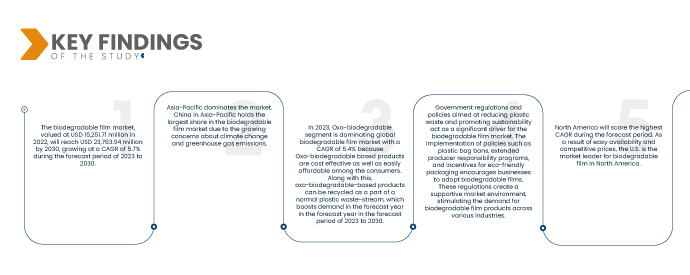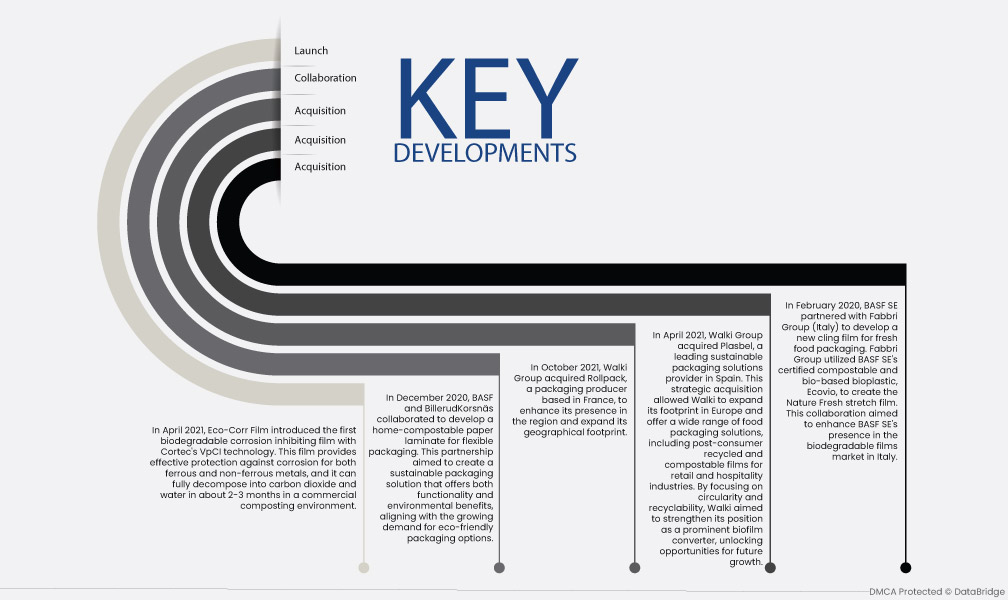El mercado de películas biodegradables está experimentando un crecimiento significativo impulsado por la creciente demanda de soluciones de embalaje sostenibles en diversas industrias. El impacto ambiental negativo de las películas plásticas no biodegradables ha impulsado el auge de las alternativas biodegradables. El sector agrícola y hortícola es un área de aplicación clave para las películas biodegradables, con especial atención a la optimización del uso del agua. Las oportunidades de crecimiento demuestran el potencial de las películas biodegradables para transformar la industria del embalaje.
Acceda al informe completo en https://www.databridgemarketresearch.com/reports/global-biodegradable-film-market
Data Bridge Market Research analiza que el mercado global de películas biodegradables , valorado en USD 15.251,71 millones en 2022, alcanzará los USD 23.763,94 millones para 2030, creciendo a una CAGR del 5,7% durante el período de pronóstico de 2023 a 2030. Las crecientes preocupaciones ambientales y la conciencia sobre la contaminación por residuos plásticos impulsan la demanda de películas biodegradables como una solución de envasado ecológica que puede descomponerse naturalmente y reducir la acumulación de residuos en vertederos y océanos.
Principales hallazgos del estudio
Se espera que la creciente demanda de las industrias de uso final impulse la tasa de crecimiento del mercado.
La creciente demanda de las industrias de consumo final es un factor clave para el mercado de películas biodegradables. Industrias como la de alimentación y bebidas, la agricultura, la cosmética y la farmacéutica reconocen la importancia de adoptar soluciones de envasado sostenibles para satisfacer las preferencias de los consumidores y las normativas ambientales. Las películas biodegradables ofrecen ventajas como un menor impacto ambiental, reciclabilidad y compatibilidad con estrategias de marca ecológicas. Por ello, estas industrias buscan activamente opciones de películas biodegradables para mejorar el envasado de sus productos, protegerlos y demostrar su compromiso con la sostenibilidad. Esta creciente demanda de diversas industrias de consumo final impulsa el crecimiento del mercado de películas biodegradables.
Alcance del informe y segmentación del mercado
Métrica del informe
|
Detalles
|
Período de pronóstico
|
2023 a 2030
|
Año base
|
2022
|
Años históricos
|
2021 (personalizable para 2015-2020)
|
Unidades cuantitativas
|
Ingresos en millones de USD, volúmenes en unidades, precios en USD
|
Segmentos cubiertos
|
Tipo (PLA, mezclas de almidón, poliéster biodegradable, PHA, a base de soja, a base de celulosa, a base de lignina y otros), tipo de producto (oxobiodegradable e hidrobiodegradable), tipo de cultivo (frutas y verduras, cereales y oleaginosas, flores y plantas y otros), aplicación (envasado de alimentos, agricultura y horticultura, productos cosméticos y de cuidado personal, envasado industrial y otros)
|
Países cubiertos
|
EE. UU., Canadá, México, Brasil, Argentina, Resto de Sudamérica, Alemania, Francia, Italia, Reino Unido, Bélgica, España, Rusia, Turquía, Países Bajos, Suiza, Resto de Europa, Japón, China, India, Corea del Sur, Australia y Nueva Zelanda, Singapur, Malasia, Tailandia, Indonesia, Filipinas, Resto de Asia-Pacífico, Emiratos Árabes Unidos, Arabia Saudita, Egipto, Israel, Sudáfrica, Resto de Oriente Medio y África.
|
Actores del mercado cubiertos
|
BASF SE (Alemania), Biogeneral (EE. UU.), TAGHLEEF INDUSTRIES GROUP (EAU), Polyplex (India), Walki Group Oy (Finlandia), Kingfa SCI. & TECH. CO., LTD. (China), Plascon Group (EE. UU.), Grafix Plastics (EE. UU.), Profol GmbH (EE. UU.), BioBag Americas, Inc. (Florida), Polystar Plastics Ltd (Reino Unido), Accredo Packaging, Inc. (EE. UU.)
|
Puntos de datos cubiertos en el informe
|
Además de los conocimientos sobre escenarios de mercado, como el valor de mercado, la tasa de crecimiento, la segmentación, la cobertura geográfica y los principales actores, los informes de mercado seleccionados por Data Bridge Market Research también incluyen un análisis profundo de expertos, epidemiología de pacientes, análisis de la cartera de productos, análisis de precios y marco regulatorio.
|
Análisis de segmentos:
El mercado de películas biodegradables está segmentado según el tipo, tipo de producto, tipo de cultivo y aplicación.
- Según el tipo, el mercado global de películas biodegradables se segmenta en PLA, mezclas de almidón, poliéster biodegradable, PHA, a base de soja, a base de celulosa, a base de lignina, entre otros. Los poliésteres biodegradables se subdividen en PCL, PBAT y PBS. En 2023, el segmento de mezclas de almidón, con una tasa de crecimiento anual compuesta (TCAC) del 6,1 %, domina el mercado global de películas biodegradables, ya que estas películas poseen buenas propiedades y presentan, comparativamente, menos efectos ambientales adversos. Esto les proporciona una resistencia y estabilidad excepcionales, lo que impulsa su demanda en el período de pronóstico de 2023 a 2030.
En 2023, el segmento de mezclas de almidón dominará el mercado mundial de películas biodegradables.
En 2023, el segmento de mezclas de almidón dominará el mercado global de películas biodegradables, con una tasa de crecimiento anual compuesta (TCAC) del 6,1% gracias a su versatilidad y características ecológicas. Las mezclas de almidón son polímeros biodegradables elaborados a partir de recursos renovables como almidón de maíz, patata o tapioca, combinados con otros materiales biodegradables. Estas películas tienen amplias aplicaciones en envases, películas agrícolas y otras industrias gracias a su excelente biodegradabilidad, bajo coste y propiedades mecánicas comparables a las de los plásticos convencionales durante el período de pronóstico de 2023 a 2030.
- Según el tipo de producto, el mercado global de películas biodegradables se segmenta en oxobiodegradables e hidrobiodegradables. Tanto las películas biodegradables oxodegradables como las hidrodegradables se dividen a su vez en PLA, mezclas de almidón, poliéster biodegradable, PHA, a base de soja, a base de celulosa, a base de lignina y otras. En 2023, el segmento oxobiodegradable dominará el mercado global de películas biodegradables con una tasa de crecimiento anual compuesta (TCAC) del 5,4%, gracias a su rentabilidad y fácil acceso para los consumidores. Además, los productos oxobiodegradables pueden reciclarse como parte del flujo normal de residuos plásticos, lo que impulsará la demanda en el período de pronóstico de 2023 a 2030.
- Según el tipo de cultivo, el mercado global de películas biodegradables se segmenta en frutas y verduras, cereales y oleaginosas, flores y plantas, entre otros. Cada uno de estos segmentos se subdivide en PLA, mezclas de almidón, poliéster biodegradable, PHA, a base de soja, a base de celulosa y a base de lignina, entre otros. En 2023, se espera que el segmento de cereales y oleaginosas domine el mercado de películas biodegradables con una tasa de crecimiento anual compuesta (TCAC) del 6,0% gracias a su excelente compatibilidad con alimentos y a su excepcional resistencia y estabilidad, lo que impulsará su demanda durante el período de pronóstico de 2023 a 2030.
- Según su aplicación, el mercado global de películas biodegradables se segmenta en envases de alimentos, agricultura y horticultura, productos cosméticos y de cuidado personal, envases industriales, etc. Cada uno de estos segmentos se subdivide en PLA, mezclas de almidón, poliéster biodegradable, PHA, a base de soja, a base de celulosa y a base de lignina, entre otros. En 2023, el segmento de agricultura y horticultura dominará el mercado global de películas biodegradables con una tasa de crecimiento anual compuesta (TCAC) del 65,9 %, debido a su amplio uso en aplicaciones agrícolas y hortícolas para aumentar la eficiencia del uso del agua, lo que impulsará su demanda en el período de pronóstico de 2023 a 2030.
En 2023, el segmento de agricultura y horticultura dominará el mercado mundial de películas biodegradables.
En 2023, el sector de la agricultura y la horticultura domina el mercado mundial de películas biodegradables, con una tasa de crecimiento anual compuesta (TCAC) del 5,9%, gracias a su amplia adopción en estas industrias para diversas aplicaciones. Las películas biodegradables se utilizan como acolchados, cubiertas de invernaderos y películas biodegradables para el suelo, entre otros. Estas películas ayudan a mejorar la calidad del suelo, conservar el agua, controlar el crecimiento de malezas y proteger los cultivos, lo que las convierte en un componente esencial de las prácticas agrícolas modernas y sostenibles.
Actores principales
Data Bridge Market Research reconoce a las siguientes empresas como los principales actores del mercado mundial de películas biodegradables: BASF SE (Alemania), Biogeneral (EE. UU.), TAGHLEEF INDUSTRIES GROUP (EAU), Polyplex (India), Walki Group Oy (Finlandia), Kingfa SCI. & TECH. CO., LTD. (China), Plascon Group (EE. UU.), Grafix Plastics (EE. UU.).
Desarrollos del mercado
- En febrero de 2020, BASF SE se asoció con Fabbri Group (Italia) para desarrollar una nueva película adhesiva para el envasado de alimentos frescos. Fabbri Group utilizó Ecovio, el bioplástico compostable y de origen biológico certificado de BASF SE, para crear la película estirable Nature Fresh. Esta colaboración tuvo como objetivo fortalecer la presencia de BASF SE en el mercado italiano de películas biodegradables.
- En abril de 2021, Walki Group adquirió Plasbel, proveedor líder de soluciones de envasado sostenible en España. Esta adquisición estratégica permitió a Walki expandir su presencia en Europa y ofrecer una amplia gama de soluciones de envasado de alimentos, incluyendo films reciclados posconsumo y compostables para los sectores minorista y hostelero. Al centrarse en la circularidad y la reciclabilidad, Walki buscaba consolidar su posición como un destacado convertidor de biofilm, abriendo oportunidades de crecimiento futuro.
- En octubre de 2021, Walki Group adquirió Rollpack, un productor de envases con sede en Francia, para mejorar su presencia en la región y expandir su presencia geográfica.
- En diciembre de 2020, BASF y BillerudKorsnäs colaboraron para desarrollar un laminado de papel compostable en casa para envases flexibles. Esta colaboración tuvo como objetivo crear una solución de envasado sostenible que ofrezca tanto funcionalidad como beneficios ambientales, en línea con la creciente demanda de opciones de envasado ecológicas.
- En abril de 2021, Eco-Corr Film presentó la primera película biodegradable inhibidora de corrosión con tecnología VpCI de Cortec. Esta película proporciona una protección eficaz contra la corrosión tanto para metales ferrosos como no ferrosos, y se descompone completamente en dióxido de carbono y agua en un periodo de 2 a 3 meses en un entorno de compostaje comercial.
- En diciembre de 2019, las películas Bioska de Walki fueron reconocidas como una de las películas de biodegradabilidad más rápidas del mercado. El Instituto Finlandés del Medio Ambiente estudió la biodegradabilidad de diversos polímeros de origen biológico y biodegradables y descubrió que las películas Bioska de Walki Plastiroll presentaban una biodegradabilidad rápida.
Análisis regional
Geográficamente, los países cubiertos en el informe del mercado mundial de películas biodegradables son EE. UU., Canadá y México en América del Norte, Alemania, Francia, Reino Unido, Países Bajos, Suiza, Bélgica, Rusia, Italia, España, Turquía, Resto de Europa en Europa, China, Japón, India, Corea del Sur, Singapur, Malasia, Australia, Tailandia, Indonesia, Filipinas, Resto de Asia-Pacífico (APAC) en Asia-Pacífico (APAC), Arabia Saudita, Emiratos Árabes Unidos, Sudáfrica, Egipto, Israel, Resto de Medio Oriente y África (MEA) como parte de Medio Oriente y África (MEA), Brasil, Argentina y Resto de América del Sur como parte de América del Sur.
Según el análisis de investigación de mercado de Data Bridge:
Asia-Pacífico es la región dominante en el mercado mundial de películas biodegradables durante el período de pronóstico 2023-2030
Asia-Pacífico domina el mercado de películas biodegradables, con China acaparando la mayor cuota. Esto se debe a la creciente preocupación por el cambio climático y las emisiones de gases de efecto invernadero en la región. A medida que los gobiernos y las industrias buscan soluciones sostenibles, la demanda de películas biodegradables ha aumentado significativamente.
Se estima que América del Norte será la región de más rápido crecimiento en el mercado mundial de películas biodegradables durante el período de pronóstico 2023-2030.
En Norteamérica, Estados Unidos lidera el mercado de películas biodegradables con la mayor tasa de crecimiento anual compuesta (TCAC) proyectada. La disponibilidad de películas biodegradables y sus precios competitivos han contribuido a su adopción generalizada en diversas industrias. El mercado estadounidense se ve impulsado por el creciente énfasis en la sostenibilidad ambiental y las regulaciones que promueven el uso de materiales ecológicos.
Para obtener información más detallada sobre el informe del mercado global de películas biodegradables, haga clic aquí: https://www.databridgemarketresearch.com/reports/global-biodegradable-film-market












